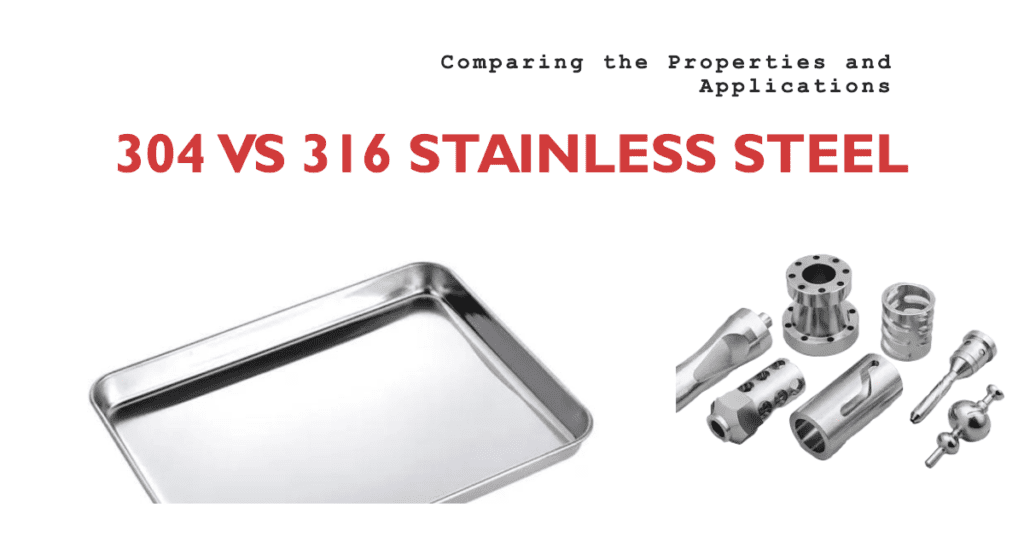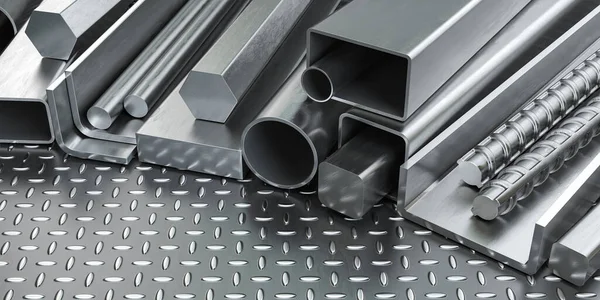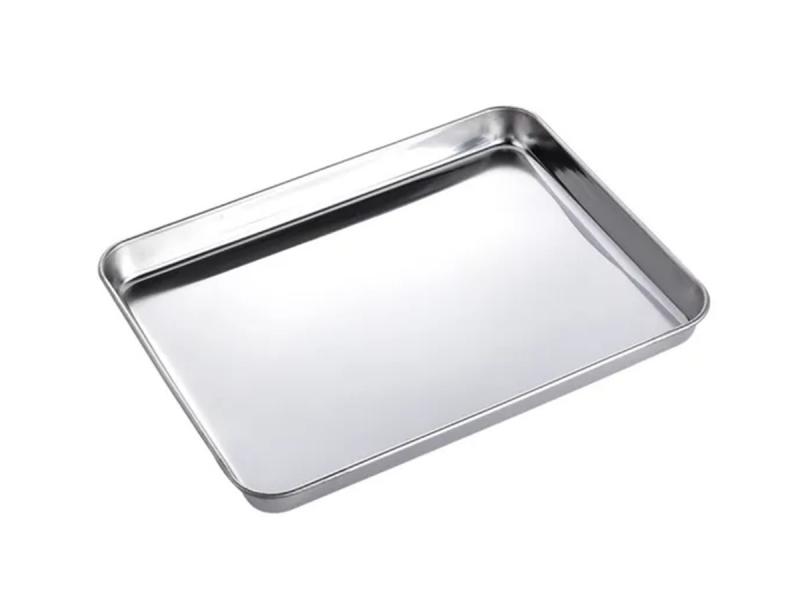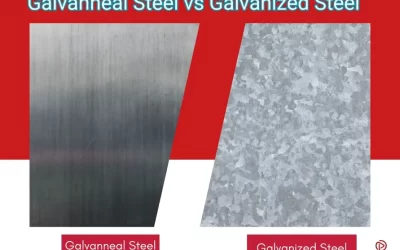
Stainless steel, with its unmatched resistance to corrosion and exceptional durability, is a common material in numerous industries. Among its numerous grades, 304 and 316 stainless steel are two of the most prevalent and popularly used. Despite their similarities, these two grades have key differences that can significantly impact their application. This comprehensive guide aims to elucidate these differences, dive into their distinct properties, and highlight the specific scenarios where one might be preferred over the other.
The Stainless Steel Family: A Brief Overview
Stainless steel is more than just a shiny material used for cutlery and watchbands. At its core, it is an alloy that boasts a unique combination of durability, resistance, and aesthetic appeal. Its history, composition, and grading system are complex yet intriguing.

Stainless steel in different shapes
The story of stainless steel began in the early 20th century when metallurgists started to experiment with different alloy combinations. They aimed to find a material that resisted corrosion while retaining the strength of steel. By 1913, Harry Brearley of Sheffield, England, discovered that adding a minimum of 12% chromium to steel made it stainless, paving the way for the materials we know today.
The Underlying Composition
At its most basic, stainless steel is an alloy of iron and carbon. However, it’s the addition of other elements that bestow it with its distinct characteristics.
Table: Common Elements in Stainless Steel and Their Functions
| Element | Typical Percentage | Primary Function |
|---|---|---|
| Iron | >50% | Base material |
| Chromium | 10.5-30% | Provides resistance to staining, rusting, and corrosion |
| Carbon | <2% | Increases hardness but reduces toughness |
| Nickel | 0-35% | Enhances corrosion resistance and changes structure from ferritic to austenitic |
| Molybdenum | 0-7% | Increases resistance to chloride corrosion |
Grading System and Common Grades
Stainless steel grades are numerical codes assigned based on their composition and properties. These grades help users and producers determine the suitability of a specific type of steel for an application.
Bulleted list of popular grades and their properties:
- 304: The most common grade; excellent forming and welding properties.
- 316: Contains molybdenum for better corrosion resistance, especially to chlorides.
- 410: A hard, strong, but less ductile martensitic variant.
- 430: A commonly used ferritic grade.
- 2205: A duplex grade is known for its high strength and corrosion resistance.
Understanding 304 Stainless Steel

The most widely used grade of stainless steel, 304, often dubbed the ‘workhorse’ of the stainless family, offers a winning combination of corrosion resistance, weldability, and formability.
Stainless steel type 304 is part of the austenitic family. This composition is what primarily gives the alloy its notable properties.
Table: Elemental Composition of 304 Stainless Steel
| Element | Percentage |
|---|---|
| Iron | >68% |
| Chromium | 18-20% |
| Nickel | 8-10.5% |
| Carbon | <0.08% |
| Manganese | <2% |
| Silicon | <1% |
| Phosphorus | <0.045% |
| Sulfur | <0.03% |
Key Properties & Applications of 304 Stainless Steel
304 stainless steel is widely used due to its excellent combination of corrosion resistance, formability, and weldability. It offers robust resistance against corrosive elements and can be easily shaped into diverse structures without compromising its integrity. Additionally, it can be readily welded by a wide range of processes, ensuring its widespread use in fabricated products.
Overall, 316 stainless steel is ideal for specialized applications that require enhanced resistance to chlorides. It is known for its strong formability, high-temperature tolerance, and weldability. Its enhanced properties make it apt for marine environments, chemical processing plants, medical surgical instruments, and pharmaceutical equipment.
So, 304’s versatility is evident when we explore the realms of its applications:
- Kitchen Equipment: From cutlery to countertops, the non-reactive nature of 304 makes it ideal for food preparation surfaces.
- Architectural Panels and Trims: Its aesthetic appeal combined with durability ensures 304 is often chosen for architectural elements.
- Chemical Containers: Due to their corrosion-resistant nature, even for chemicals.
- Heat Exchangers: 304 can resist high temperatures, making it suitable for such applications.
A Deep Dive into 316 Stainless Steel

Often referred to as marine-grade stainless steel due to its enhanced resistance to chloride corrosion, 316 stainless steel offers superior qualities that make it ideal for a range of demanding applications.
316 is also austenitic stainless steel, but its composition differs slightly from 304, especially with the addition of molybdenum.
Table: Elemental Composition of 316 Stainless Steel
| Element | Percentage |
|---|---|
| Iron | >62% |
| Chromium | 16-18% |
| Nickel | 10-14% |
| Carbon | <0.08% |
| Molybdenum | 2-3% |
| Manganese | <2% |
| Silicon | <1% |
| Phosphorus | <0.045% |
| Sulfur | <0.03% |
Key Properties & Applications of 316 Stainless Steel
316 stainless steel is a popular choice for specialized applications due to its enhanced corrosion resistance to chlorides, strong formability, high-temperature tolerance, and weldability. With the addition of molybdenum, it is ideal for marine environments, chemical processing plants, medical surgical instruments, and pharmaceutical equipment. However, it generally costs more than 304 and is slightly heavier, which may be a consideration for certain applications.
It is ideal for numerous applications, including kitchen equipment, architectural panels and trims, chemical containers, and heat exchangers. Its non-reactive nature makes it ideal for food preparation surfaces, and its ability to resist high temperatures makes it suitable for heat exchangers.
316 finds applications in specialized areas:
- Marine Environments: Its resistance to saltwater corrosion makes it apt for shipbuilding, docks, and other marine applications.
- Chemical Processing Plants: The enhanced resistance ensures longevity in corrosive environments.
- Medical Surgical Instruments: Due to its non-reactive nature.
- Pharmaceutical Equipment: Ensures the purity of drugs isn’t compromised.
Try Prolean Now!
The Head-to-Head: 304 vs 316 Stainless Steel
As two of the most commonly used grades within the stainless steel family, both 304 and 316 have found their place in various industries and applications. Yet, when it comes to choosing between them, understanding their differences, benefits, and limitations is crucial.
Now, let’s break down this matchup in detail.
Core Compositional Differences
At their core, both 304 and 316 belong to the austenitic class of stainless steel, which means they have similar foundational elements. However, the minor variations in their composition are what make all the difference.
Table: Compositional Differences between 304 and 316 Stainless Steel
| Element | 304 Stainless Steel | 316 Stainless Steel |
|---|---|---|
| Chromium | 18-20% | 16-18% |
| Nickel | 8-10.5% | 10-14% |
| Molybdenum | Absent | 2-3% |
The addition of molybdenum in 316 is what provides it with enhanced resistance, especially in chloride-rich environments.
Performance Under Corrosion
Both these steels have commendable resistance to corrosion, but their performance differs in certain environments:
- General Environments: Both 304 and 316 offer robust resistance to a variety of everyday settings.
- Saltwater and Chloride-rich Environments: Here, 316 clearly takes the lead. Its molybdenum content makes it more resistant to chloride-induced corrosion. This explains why 316 is often termed marine-grade stainless steel.
- Acidic Environments: Depending on the concentration and temperature of the acid, both steels might show varying levels of resistance.
Durability and Strength
Both 304 and 316 are strong contenders when it comes to strength and durability. However, 316, due to its molybdenum content, often displays slightly higher strength and durability in aggressive environments.
Table: Tensile Strength Comparison
| Steel Grade | Yield Strength (MPa) | Tensile Strength (MPa) |
|---|---|---|
| 304 | 205 | 515 |
| 316 | 205-220 | 515-690 |
Other Properties Comparison
In addition to the commonly compared factors like corrosion resistance and strength, the properties of 304 and 316 stainless steels encompass various other vital parameters. These range from their machinability to heat resistance and weldability. Each of these properties plays an integral role in determining their suitability for specific applications. Here’s a detailed comparison of some of these key attributes:
Table: Comparison of Properties between 304 and 316 Stainless Steel
| Property | 304 Stainless Steel | 316 Stainless Steel |
|---|---|---|
| Machinability | Offers excellent machinability, easing the process of cutting, shaping, and forming. | Machinable but might present a slightly more challenging experience due to its enhanced hardness. |
| Heat Resistance | Can continuously endure temperatures up to 870°C. Intermittently, it can handle up to 925°C. | Suitable for continuous exposure to temperatures up to 925°C and intermittent exposure up to 870°C. |
| Weldability | Exceptional weldability, ensuring smooth and effective joins. | Provides excellent weldability, but certain precautions may be needed depending on the specific application due to its composition. |
| Cost Implications | Typically less expensive due to its composition. | Generally more expensive, owing to its molybdenum content and enhanced properties. |
304 vs 316 Stainless Steel Machining
Stainless steel machining presents unique challenges due to the material’s inherent properties. The stainless steel grades 304 and 316, while both extremely popular for various applications exhibit different machining characteristics.
Both 304 and 316 stainless steel grades belong to the austenitic family, which inherently means they possess certain machining challenges, such as work hardening. While they might not be the easiest metals to machine, understanding their characteristics can lead to more efficient machining practices.
Now, let’s compare 304 & 316 stainless steel in terms of machining under different machining criteria;
1. Work Hardening
Work hardening, or cold working, refers to the phenomenon wherein metals become harder and stronger as they are deformed. Stainless steels, including 304 and 316, are prone to rapid work hardening during machining, which can lead to challenges.
As the steel hardens, it becomes more abrasive, leading to faster wear and tear on cutting tools. The area being machined can exhibit altered mechanical properties, impacting the component’s performance.
2. Tool Selection
Given the potential for rapid work hardening and the tough nature of both 304 and 316 stainless steels, tool selection becomes paramount.
- High-speed Steel (HSS) Tools: These can be employed but might not be as durable as other options, leading to frequent changes.
- Carbide Tools: More suitable for stainless steels due to their hardness and heat resistance. Carbide tools can maintain a sharp edge for longer, enhancing efficiency.
3. Speeds and Feeds
Adjusting machining parameters can dramatically affect the success of the machining process. 304 Stainless steel has slightly easier machinability, and higher speeds can be employed. However, operators should be cautious of generating excessive heat. On the other side, 316 stainless steel requires more attention due to its harder nature. Lower speeds and a consistent feed rate can help in avoiding excessive work hardening.
Table: Machining Parameters for 304 and 316 Stainless Steel
| Parameter | 304 Stainless Steel | 316 Stainless Steel |
|---|---|---|
| Cutting Speed (m/min) | 60-80 | 50-70 |
| Feed Rate (mm/rev) | 0.2-0.3 | 0.15-0.25 |
| Depth of Cut (mm) | 2-3 | 1.5-2.5 |
4. Cooling and Lubrication
Effective cooling and lubrication play a vital role in successful stainless steel machining. Coolants helps in temperature regulation, ensuring that the steel does not overheat and become even harder during the machining process. While lubrication facilitates smoother tool operation, reducing friction and minimizing tool wear.
5. Chip Breaking and Removal
Continuous and large chips can pose challenges during machining. Effective chip breaking is essential to ensure:
- Safety: Long chips can pose safety hazards.
- Quality: Effective chip removal ensures that the surface finish is not compromised.
- Efficiency: Regular chip evacuation reduces the chances of re-cutting chips, which can deteriorate tool life and surface finish.
6. Surface Finish
The choice between 304 and 316 might also influence the final surface finish. 304 Stainless Steel provides a slightly smoother surface after machining due to its slightly softer nature. While 316 stainless steel might require additional finishing processes, such as polishing, especially if it has undergone extensive machining.
Prolean’s Stainless Steel Machining Services
In the realm of stainless steel machining, precision, expertise, and quality control are paramount. Prolean offers a comprehensive suite of stainless steel machining services tailored to the unique challenges and strengths of stainless steel, particularly grades 304 and 316.
- Advanced Equipment: Our state-of-the-art equipment ensures that every cut, bend, and weld meets the industry’s highest standards. We continually update our machinery to leverage the latest technologies, ensuring precision and consistency.
- Expertise in Both 304 and 316: Our team boasts years of experience working with both 304 and 316 stainless steel. We understand the nuances of each grade, ensuring optimal performance and longevity for your projects.
- Custom Solutions: Every project is unique. At Prolean, we pride ourselves on providing tailored solutions to meet each client’s specific needs, whether it’s intricate design requirements, unique finishing, or specific performance attributes.
- Quality Assurance: We implement rigorous quality control at every stage of the machining process. From sourcing raw materials to the final finishing touch, Prolean ensures that each product leaving our facility meets our gold standard of quality.
Conclusion: The Stainless Steel Dichotomy Resolved
The battle between 304 and 316 stainless steel is a testament to the intricate nuances of metallurgy and its profound impact on practical applications. While both these grades offer impressive attributes in terms of durability, resistance, and versatility, the right choice hinges on specific project requirements, environmental factors, and budget considerations. Armed with an understanding of each steel’s strengths and potential applications, decision-makers can make informed choices that optimize performance, aesthetics, and value.
Whether it’s the architectural allure of coastal structures, the sterile precision of medical equipment, or the robust needs of industrial machinery, stainless steel remains a material of choice. With Prolean’s expertise in stainless steel machining, the potential to harness these materials’ full spectrum becomes even more tangible.
FAQs
What’s the primary difference between 304 and 316 stainless steel?
The main difference is the molybdenum content. 316 has added molybdenum, which offers enhanced corrosion resistance, especially in chloride environments like marine settings.
Is 316 stainless steel more expensive than 304?
Yes, generally, due to its superior corrosion resistance and molybdenum content, 316 is typically more expensive than 304.
Can both 304 and 316 stainless steels be welded efficiently?
Yes, both grades offer excellent weldability. However, specific considerations might be needed based on their individual compositions.
In which scenarios is 304 stainless steel more advantageous than 316?
304 is more advantageous in terms of cost-effectiveness for projects not exposed to high levels of salt or corrosive agents.
Are both 304 and 316 stainless steels magnetic?
In the annealed condition, both 304 and 316 stainless steels are generally non-magnetic. However, they can become magnetic when cold works.
How does the machinability of 316 compare to that of 304?
Both are machinable, but 304 typically offers a slightly easier machining experience than 316 due to its composition and structure




0 Comments